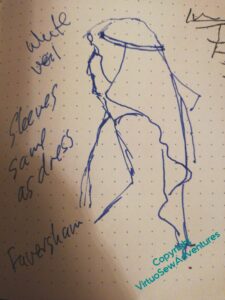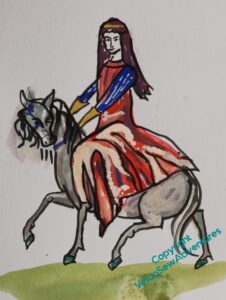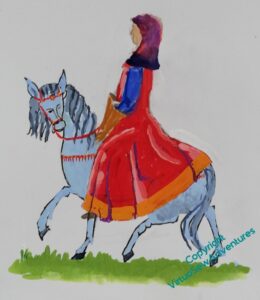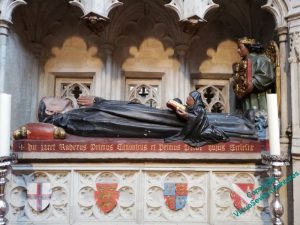Tag: Medieval Movers And Shakers
More Planning for Aethelflaed
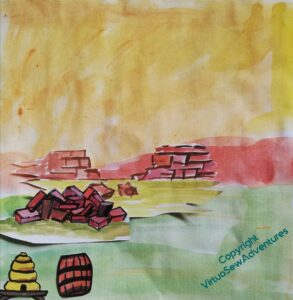
As I have thought about Aethelflaed and begun to plan the design of her panel, I’ve also begun to plan what the background will look like.
Brought up, as I was, in Chester, the obvious point in her life to choose is her defense and refortification of Chester. So the stone for the wall is the distinctive dark pinkish sandstone of Cheshire, and in reference the the beehives and boiling beer turned on the Viking assault, I have a barrel and a bee skep ready for deployment.

But I need something that I can try to place Aethelflaed against, and strong enough in colour to give me a start on picking her colours, so I’ve redone some of it to give me something to work with. Although I do feel that maybe the wall isn’t high enough.
While I’m working on the walls of Chester, I also need to work a bit more on Aethflaed and her horse. The pair of them are proving much trickier than William, mostly because examples of horsemen aren’t hard to find in medieval art. I only had to decide on a few tweaks of presentation and insert the appropriate coat of arms. Aethelflaed is being invented as I go.

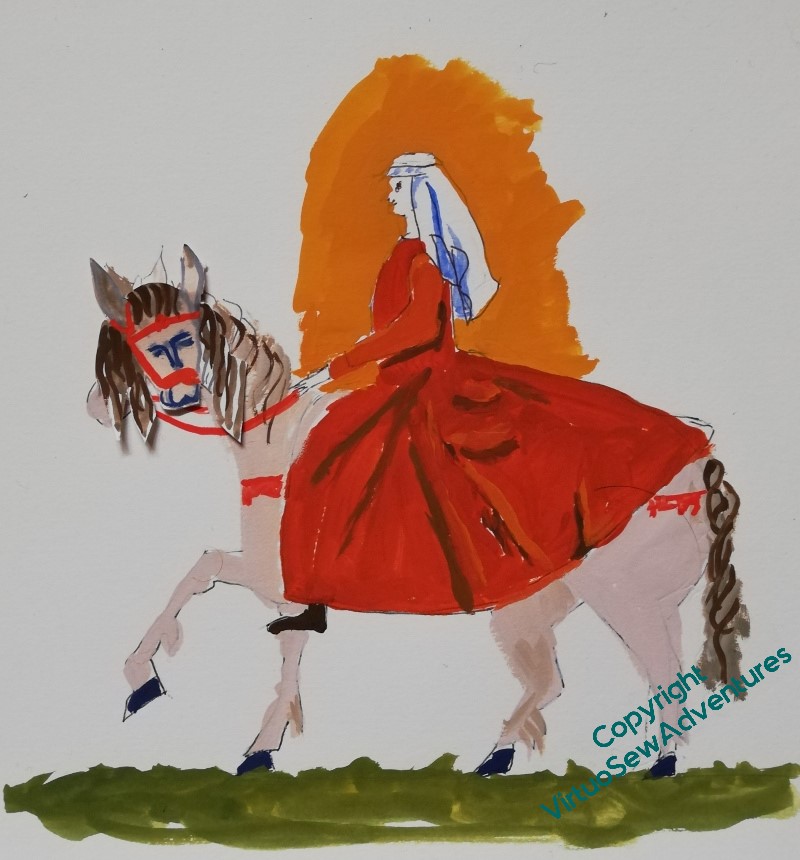
In fact, the invention, reinvention, and re-reinvention continues! I think the horse has become a little too long-backed, and needs to be a bit madder. And I’m not sure that Aethelflaed is in suitable proportion to him. What I might do is go back to the original horse, and indeed, the original lady, and then work forward (yet) again, using all the information I now have.
All this planning is keeping me from stitching, and I’m getting twitchy!
Another experiment in Trapunto..

Remember this?
I wanted to have a go at creating some Anglo Saxon jewels as a possible ornament for however I end up displaying Aethelflaed. It was enough of a success that I felt that, with some fiddling around, I might be able to produce something suitable. And since this one was very much thrown together from things I had to hand, there’s a lot of fiddling around to do!

And here you see some of it. I went looking for materials, this time, and thought it through a bit more.
So, crimson gauze laid over gold tissue, laid in turn over calico for support. The gold tissue may be a good idea for the effect in real life, but it is a complete nightmare to photograph, and I apologise in advance for the peculiar changes of colour the fabric will undergo!
I used back stitch in a single strand, rather than split stitch in two, but took more or less the same approach to the outer channels, filling them with woollen thread. I was a little inconsistent in how I did so, which is why you see little bits of wool above the gauze – something I didn’t want, but struggled not to do. There must be a trick to trapunto quilting without going permanently demented, but I’m not sure I have it yet!

I should probably also apologise for my photography..
Anyway, the next bit was why I wanted to include the gold tissue in my sandwich of fabrics. If you look at the Sutton Hoo helmet and some other Anglo Saxon items, you will see that in some cases the gems look lighter than others, and it has been determined that that is because they’ve been backed with gold foil. I’m trying to get the same effect here, but in the case of fabric by inserting the filling behind the gold tissue.
This was very nearly as unnerving a proceeding as when I was doing much the same thing at the beginning of Akhenaten. You’d think I would have learnt sense by now, wouldn’t you!
More on Aethelflaed
So, after my first two attempts at Aethelflaed, I had a fascinating day with my reenactor friend Vara, talking about the garments and decorations of the period, and she showed me this photo of her daughter riding astride, but in a modern riding dress inspired by early medieval garments.
Rowanne is apparently intrigued by what I’m doing, and has given permission for me to put this picture up, showing her and her horse Lola!
I also had a chance to do a sketch of a woman in profile, wearing the right sort of veil, complete with a fillet, with the added suggestion that Aethelflaed should be wearing a bright white veil, since that would be a sign of wealth and authority, and that sleeves would have been all in one with the dress.
So, I’ve had a bit more to work with, and had another go.
This is better, I like the straighter back, and the dress covering the horse’s rump. But my goodness, if you compare her with Rowanne and Lola, she’s much too long in the body. I need to shorten her somewhat.
Furthermore, I think the horse has got too tame – back to the cross-eyed one staring out at the viewer!
But then, I think, I might be able to start playing around with placing her on the background and choosing colours for her. Which, my goodness, will be About Time!
Working on Aethelflaed
You may recall that the planning and designing of Aethelflaed is proving quite a long winded process, with a lot of repetition and rethinking going on.
I’ve been looking for medieval women on horseback, because I want Aethelflaed under her own steam, as it were – not lead on a palfrey, but mounted on her own horse, with the reins in her hands.
The best I’ve found so far is this one, which I think was in the Holkham Picture Book Bible.
I started with the lady, and began some alterations. I want her horse to have some personality, so I’ve turned the head towards us, and lifted it a little.
I’ve extended the skirts somewhat, and given the rider a veil that flies a little, held in place by a golden fillet.
But the high contrast suggests a silk or brocade, and I want something that suggests a sensible woollen riding dress.
Then I found some Viking and Anglo-Saxon reenactors and talked to them. And goodness, that gave me food for thought. In particular, yes, riding dress was indeed a garment that an Anglo Saxon woman like Aethelflaed might have worn. But Anglo-Saxon dressmaking was not at all like ours.
In particular, whereas we tend to have pattern pieces that start with the widest part, and remove fullness by means of darts, pleats, or gathers, Anglo-Saxon dressmaking started with the narrowest width and added fullness by means of gussets and gores. In fact, an Anglo Saxon riding dress would have a full circle’s worth of gores inserted into the side seams, resulting in something roughly like this.
But not quite. I’ve actually been to talk to my reenactor friends, and there are a few bits which don’t quite ring true. I have some photos to work from, so there is more to come…
An Experiment For Aethelflaed
I’m beginning to realise that if I take into account at the beginning of a project the final destination of it or the way it’s going to be displayed, life might be a bit easier.
I think the Medieval Movers and Shakers may end up displayed on banners, but while the clerics Rahere and Dame Julian should probably be on a simple vertical drop, like a pulpit fall, I think William and Aethelflaed might want somethiing more ornate.
With that in mind, one idea I had for Aethelflaed was to ornament her banner with reproductions of Anglo Saxon jewels in trapunto quilting. Easier said than done, and I don’t imagine I’ll get it right first time, so I hope that this will give me some thoughts!
Trapunto involves creating channels and cells that can then be filled with coloured yarns or wool. This experiment is done using leftover gauze from the Amarna overlays, and the design was quite roughly hand-drawn to make a first approximation, but in due course I had all the lines done in split stitch.
Then it was time to fill in the channels and cells. Mindful of my recent experience with the Golden Accessories, when I found there was definitely a Right Order in which to fill in the strapwork, I did (believe it or not!) pause for thought before just barrelling in. I think I made the right choice – the channels are quite narrow, and it was definitely easier to fill them in first. I’ve used tapestry wool, and I’m not sure that’s necessarily the best choice, but it’s the right sort of colour, and with the narrow channels, it’s easier than fleece. Especially as I don’t have any to hand!
The final stage was to fill in the cells – this time with Paternayan. I think I would prefer to use fleece for cells, to avoid having shadow lines between the “stitches”, but as a first attempt, I think it’s worked well.
Two layers of gauze are a bit much, though, I think it would be easier to manage if the backing were in calico. So next time I have a moment for this sort of experimentation, I might start with that, and maybe a different shade of gauze.
Research for Aethelflaed
I think I’m going to try to do Aethelflaed next.
At the moment, my thought is to have her riding (side-saddle) towards the refortification works at Chester (which is where I grew up). I looked up “side-saddle”, owing to having some doubts about how recent or not it might be, and the history and techniques of riding sidesaddle seem more complex than would at first appear.
Of course they are.
There’s the technique you probably think of first, with a leg hooked up and the rider facing forwards (think Queen Elizabeth II riding Burmese to Trooping The Colour, way back when). The development of that design is credited to Anne of Bohemia, Richard II’s Queen, so it would be anachronistic, to say the least, for Aethelflaed. However… The older style is more like a chair set on the horse’s back, with a footboard, and the rider faces sidesways. Generally the horse is then lead, either by a someone on foot, or by another rider, but I simply cannot imagine Aethelflaed not being under her own steam, as it were. I suspect that she would just have a really voluminous skirt or a slit skirt or even just wear men’s clothing and ride astride. But that would not create the image I want, so I’m going to have to balance storytelling with other concerns. Well, that’s part of what is interesting to me, so that’s ok!
I had a lovely day out a little while ago to see the Staffordshire Hoard exhibition at the Museum in Stoke on Trent. It’s the closest source I can find for patterns that I might be able to use, and although none of these sketches or photos will be useable directly, I can, for example, imagine taking the style of that processional cross in the grid at the top, sketched in the grid to the side here, and using that at the cardinal points of the border.
I’m also wondering about taking one of the patterns from the pieces in the Hoard, and turning it into a border design, somehow. That might make everything a bit busy, so, more thought needed…
Research for Rahere
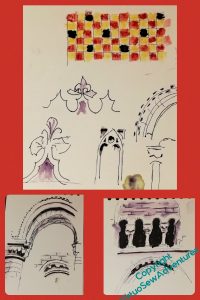
I had another chance to go to the Church of St Bartholomew The Great in Spitalfields recently, and managed to get in a solid couple of hours of sketching and thinking while I was about it. I did attract a bit of attention – someone came and asked whether they could take my photo as I sketched, and even photographed the sketch itself, but it was in the morning on a cold and wet Saturday, so there wasn’t too much activity. By the time the tour groups started to come in and obscure what I wanted to sketch, I was becoming chilled and clumsy and in need of food and a hot cup of tea.
I might use that coloured tile pattern in the border of Rahere’s panel, instead of a plain colour. I think I’d want to make the colours closer, to create the effect of a rich damask-type fabric, but I feel a bit wider variation is needed among the four panels. I want each of them to stand alone, but if they end up displayed together, they need to look happy…
I had been wondering whether it would be legitimate to include scallop shells in the borders, to reference pilgrimage, since most often I have heard of the scallop shell being associated with the Camino to Compostela. Plainly the makers of the pews thought so!
I’m still trying to work out what to set behind Rahere. Arches? A single arch, maybe, with the gold underside couching within. That may be a bit too reminiscent of a halo, and no-one, as far as I know, has ever even suggested Rahere as a candidate for sainthood. If Kipling’s version of him has any veracity (it’s certainly not based on research – you might call it a possible emotional truth), he’s very much in the category of people who make for an challenging example – speaking truth to power is not a gift we all have, although we may all agree that it is important that it happens.
In truth I think he’s more valuable as an example to follow without the accolade. He is credited with founding an institution which continues to provide healthcare, 900 years after foundation, he is still remembered, and no one suggests that what he did is the less valuable for the lack of a sainthood.
As you see – he is still remembered.
More on Mother Julian and Rahere
I have a steadily extending bookshelf of reference material. Not all useful, alas, but in this stage I never know what is useful until I get there, so I just have to keep reading.
I’m trying to plan the borders for my planned pieces – these are companions for William Marshall, after all, so the basic style of the designs needs to match his. So, for example, since Julian of Norwich and Rahere are both clerical figures, at least to a degree, maybe I can take into account the information that the “lilies of the field” mentioned in the Bible are probably Lilium candidum, which is native to the Holy Land. Perhaps I could include them, and scallop shells (emblems of pilgrimage), and maybe London Pride (scabious urbanum?) for Rahere? Or maybe lavender or one of the healing herbs? And for Julian, the lilies of the field with hazel leaves and nuts?
I’ve started also to think about the designs themselves. Among the references I’ve not shown in that picture, I have a book of Psalms illustrated with a variety of artwork from the medieval and renaissance period. The illustrations weren’t chosen with my needs in mind, of course, so this rather scrappy effort for Julian is based on a combination of several. I’d like to have a better drapery effect when I get there, although I have to be careful not to be too exaggerated – I can’t imagine anchoresses dressed in the height of fashion!
For Rahere, I can use the drawing of the effigy on his tomb as the basis, but in his hands will be a model of the Priory and Hospital of St Bartholomew The Great, and at his feet the jester’s cap symbolising the life he rejected after the loss of The White Ship. I may have building work behind him, the beginning of a tower or a wall.
When I made my first research visit to St Bartholomew’s, I didn’t look at the outside, which may prove to be a mistake. Fortunately I am sure I will get another chance to visit!
By contrast, when I visited Mother Julian’s Church, I didn’t do a sketch inside her cell – that would have involved being terribly in the way for the people preparing for a Flower Festival later in the week. I sat in the churchyard and painted the outside, instead. Norwich is a bit more of an epic to get to from the west coast, where we are, so I may have to be Even More Imaginative for Mother Julian’s surroundings!
Researching Rahere..
It’s going to be some while before I can start stitching on the other Medieval Movers and Shakers (I’m going to have to find a better title for that quartet, they’re going to drive me demented if I don’t!), but given I have much research to do, that’s no great difficulty.
I have been accumulating books – which is also rather a delight in any case.
The history of the church Rahere founded duly arrived a week or so after our visit, and proved very interesting indeed. It included among the illustrations this engraving of the tomb effigy on Rahere’s tomb. The tomb was not made for Rahere when he died, but about four hundred years later, so one should take the likeness of the face with a pinch of salt, but I’m sure it will have got his Dominican robes right, so it may be useful in planning how I depict him. (I’ve just double checked – white cassock and black cloak, so for the purposes of the embroidery I can go for the look of undyed wool for the cassock, and dark greys and browns for the cloak).
I also found a reference to an epic poem called The Romance of Rahere, thinking it might at least be atmospheric.
Well, no. It’s set in the Civil War, about the orphan daughter of the vicar of St Bartholomew the Great who is named after the founder (poor lass) and who dies in the church during a thunderstorm, leaving the boy who wants to marry her absolutely distraught, and becoming a soldier to seek death, but surviving and returning home to right the wrongs caused by his greedy and abusive father.
So not even remotely helpful!
In the Kipling tale in which he appears, “The Tree of Justice”, Rahere, the Kings’ Jester, is described as: “more of a priest than a fool and more of a wizard than either“, and his jester’s outfit as parti-coloured in black and red. There is so little information about the person that I’m going to be using that as the basis for my characterisation. My current idea for the embroidery design is to have Rahere in his Dominican Robes, with a model of St Bartholomew the Great in his hands, and his jester’s cap at his feet. The border – well, maybe the flower London Pride, maybe bells (for the jester) and scallop shells (for pilgrimage). We’ll just have to wait and see!
Researching Rahere

A journey through London gave me the opportunity to visit the Church of St Bartholomew The Great in Smithfield, which is indeed very close to the Hospital Rahere founded, known today as St Barts.
It, and Rahere himself, have had varying fortunes and visibility over the years, and, for example, Rahere’s tomb was built in the fifteenth century, nearly four centuries after his death.
I haven’t yet discovered whose shields are displayed there, but it seems likely I will. The Rector was involved in a wedding rehearsal when I arrived, but I carried on quietly sketching and walking around the Church, staying out of the way as best I could while still continuing to work.
And I had my reward in due course, when, on the principle that Bairns As Don’t Ask, Don’t Get, I tracked him down afterwards and asked what, if any, information they had on Rahere and the early days of his foundation.
I may have bewildered him slightly – I have the impression that’s not the first thing people usually say! – but he took it well, and informed me that as this year is the anniversary of the foundation, a substantial History has been produced. So when that arrives, I shall have more to say on the subject, I’m sure!


